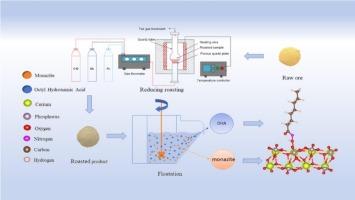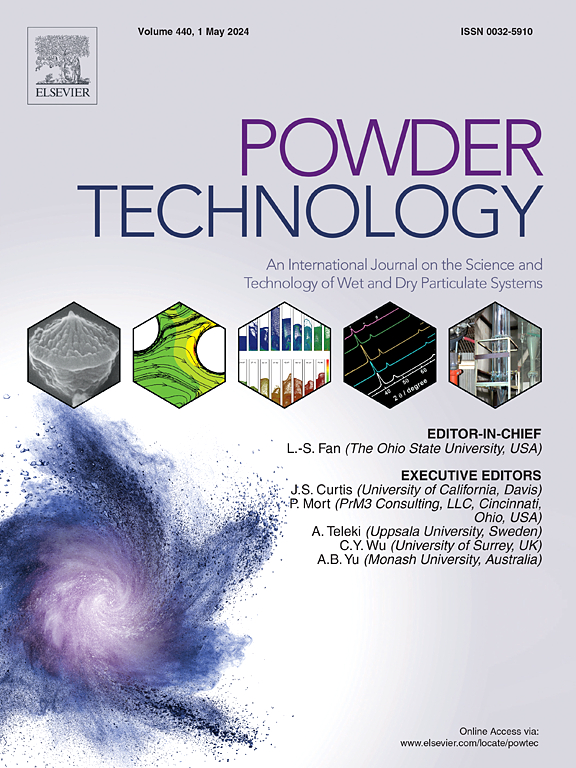辛基羟肟酸转化氢基矿相后独居石的浮选性能和吸附机理
IF 4.5
2区 工程技术
Q2 ENGINEERING, CHEMICAL
引用次数: 0
摘要
本研究探讨了影响焙烧预处理后独居石矿物浮选性能的规律。通过模拟试验,包括微浮选试验、Brunauer-Emmett-Teller(BET)分析、接触角测量、zeta电位分析、扫描电子显微镜能量色散光谱、傅里叶变换红外分析、X射线光电子能谱和DFTB+,系统研究了焙烧后独居石的浮选性能和吸附机理。微浮选试验结果表明,辛基羟肟酸(OHA)在 pH 值为 9 ∼ 9 时对独居石有较好的回收效果。在相同条件下,OHA 对独居石的浮选性能明显优于水杨羟肟酸(SHA)和苯并羟肟酸(BHA)。利用 DFTB+ 模拟并优化了焙烧后独居石的分子模型。计算了 SHA、BHA 和 OHA 的吸附能,结果表明 OHA 在焙烧后的独居石表面有很强且稳定的吸附。本文章由计算机程序翻译,如有差异,请以英文原文为准。

Flotation performance and adsorption mechanism of monazite after the transformation of hydrogen-based mineral phase by octyl hydroxamic acid
This study investigated the laws affecting flotation properties of monazite minerals after roasting pretreatment. The flotation performance and adsorption mechanism of monazite after roasting were investigated systematically through simulation tests, which included micro-flotation tests, Brunauer–Emmett–Teller (BET) analysis, contact angle measurement, zeta potential analysis, scanning electron microscopy energy dispersive spectroscopy, Fourier transform infrared analysis, X-ray photoelectron spectroscopy, and DFTB+. The results of the microflotation tests indicated that octyl hydroxamic acid (OHA) had a superior recovery effect on monazite at a pH of ∼9. The flotation performance of OHA on monazite was significantly better than those of salicylhydroxamic acid (SHA) and benzohydroxamic acid (BHA) under the same conditions. A molecular model of monazite after roasting was simulated and structurally optimized using DFTB+. The adsorption energies were calculated for SHA, BHA, and OHA, which confirmed the strong and stable adsorption of OHA on the surface of monazite after roasting.
求助全文
通过发布文献求助,成功后即可免费获取论文全文。
去求助
来源期刊

Powder Technology
工程技术-工程:化工
CiteScore
9.90
自引率
15.40%
发文量
1047
审稿时长
46 days
期刊介绍:
Powder Technology is an International Journal on the Science and Technology of Wet and Dry Particulate Systems. Powder Technology publishes papers on all aspects of the formation of particles and their characterisation and on the study of systems containing particulate solids. No limitation is imposed on the size of the particles, which may range from nanometre scale, as in pigments or aerosols, to that of mined or quarried materials. The following list of topics is not intended to be comprehensive, but rather to indicate typical subjects which fall within the scope of the journal's interests:
Formation and synthesis of particles by precipitation and other methods.
Modification of particles by agglomeration, coating, comminution and attrition.
Characterisation of the size, shape, surface area, pore structure and strength of particles and agglomerates (including the origins and effects of inter particle forces).
Packing, failure, flow and permeability of assemblies of particles.
Particle-particle interactions and suspension rheology.
Handling and processing operations such as slurry flow, fluidization, pneumatic conveying.
Interactions between particles and their environment, including delivery of particulate products to the body.
Applications of particle technology in production of pharmaceuticals, chemicals, foods, pigments, structural, and functional materials and in environmental and energy related matters.
For materials-oriented contributions we are looking for articles revealing the effect of particle/powder characteristics (size, morphology and composition, in that order) on material performance or functionality and, ideally, comparison to any industrial standard.
 求助内容:
求助内容: 应助结果提醒方式:
应助结果提醒方式:


